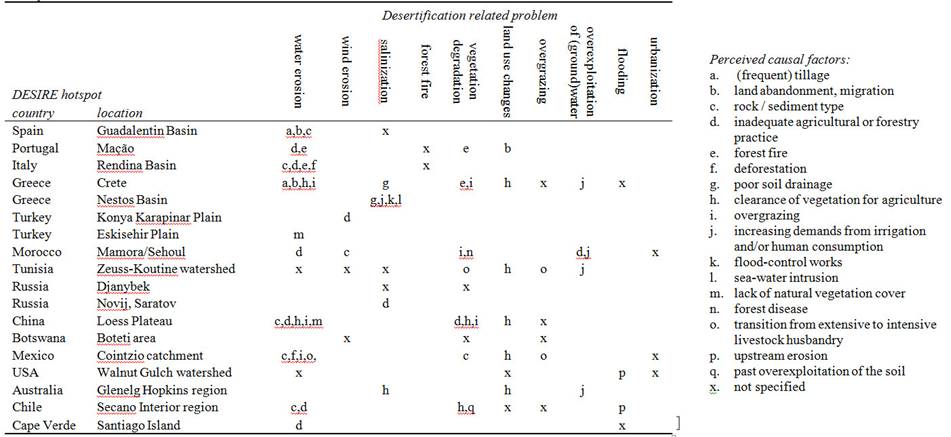Synthesis of causes for DESIRE hotspots
Since this literature review is a starting point for the DESIRE project (see Appendix I), the problems occurring in the DESIRE hotspots were analyzed regarding their causal agents. Here an overview and synthesis is given of the various problems and the factors that are perceived to be primary causes of these problems. See Chapter 4 for a more detailed description of the various desertification related problems.
In Table 3.3, all DESIRE hotspots are listed in the rows, while the perceived desertification related problems are given in the columns. If the problem is perceived but no particular reason or cause is given, this is indicated by an 'x'. If a possible cause is given for the particular problem, this is indicated with a letter, of which the explanation is given below the table (a - q). Importantly, in all hotspots the major reason for the problem included the climate. Most importantly the long period of drought and the torrential and irregular nature of rainfall were named. However, as the climate is inherent to the Mediterranean area and to desertification, and it cannot be mitigated by any realistic measure, this factor is left out of this analysis.
As can be seen from Table 3.3, causative factors differ between hotspots even if the same desertification problem is experienced, which is due to specific circumstances for each area. In total, apart from the cases where the cause is 'not specified', the two causes mentioned most often are inadequate agricultural or forestry practices and clearance of vegetation for agriculture. As not all causes are specified, research should be carried out as to what might cause the perceived problem. Once the underlying cause of the problem is known, it is easier to identify and provide a solution.
For water erosion, many factors are perceived to be causative. The most often named groups of causes are inappropriate or inadequate agricultural or forestry practices, followed by rock or sediment type. As with climate, the latter is problematic to overcome, though with adequate agricultural practices focusing on the weak soil substrate, problems might be decreased. For land use changes, the (past) clearance of natural vegetation for agricultural purposes is usually the main cause, except for the situation in Portugal where migration led to the abandonment of fields and thus to land use change. The overexploitation of water sources is almost always due to a competition between users.
Often, one desertification problem leads to another. Water erosion and urbanization upstream can be the cause of flooding and siltation of lower lying areas. Land use change leads to problems such as forest fire, water and wind erosion, overgazing etc.
Table 3.3 Synthesis of the desertification problems for each DESIRE hotspot, including perceived possible causal factors of each problem.
